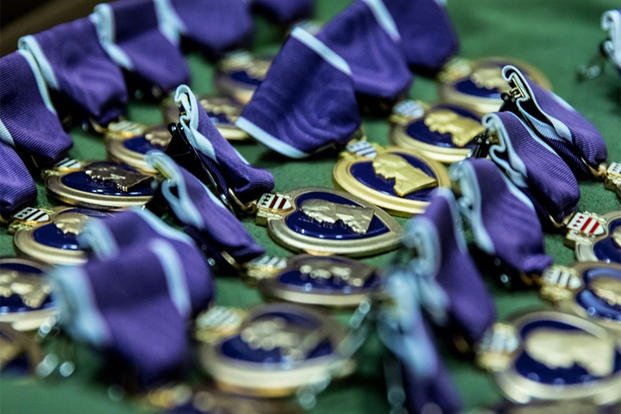The Purple Heart is a unique military award given to those wounded or killed while fighting for the United States. But did you know the history of this prestigious award?
Many Purple Hearts were created during World War II. The US produced a lot of medals in anticipation of the numerous soldiers’ injuries or deaths in the invasion of Mainland Japan. Its surplus is still awarded to this day.
History of the Purple Heart
The Purple Heart was first presented on August 7, 1782. General George Washington created it, then the commander in chief of the Continental Army. It was purple heart-shaped silk with a thin silver lining and had Merit stitched across. (Source: History)
Washington’s purple heart was meant to be sewn onto the coat of whoever received it. It was presented to soldiers for any singularly meritorious action. The bearer of the medal is also permitted to pass guards and sentinels without challenge or questioning.
Washington’s purple heart was awarded to only three Revolutionary War soldiers, Elijah Churchill, William Brown, and Daniel Bissell, Jr. Churchill received his medal for heroism on two raids against British forts in Long Island. Brown received his award for showing his gallantry while assaulting British posts in Yorktown. And Bissell was awarded for spying on British troops in New York.
Soon after, the Merit was forgotten and was not revived until almost 150 years later. At the height of World War I, General John Pershing noticed that other allied forces like the British, French, and Italian armies had numerous medals to reward valor or service. In contrast, the Americans only had the Medal of Honor. And to add to that, the Medal of Honor was only explicitly awarded for combat heroism. (Source: History)
Soon after World War I, the Army remedied the award shortage. Congress passed legislation for the Distinguished Service Cross and Distinguished Service Medal to give much-deserved recognition to service members. However, these two awards required a high degree of combat heroism or service, leaving those who had valuable wartime services unawarded.
Some officers who knew about Washington’s purple heart tried to resurrect the award but were unsuccessful. The purple heart was only renewed thanks to the efforts of General Douglas MacArthur. While the Army’s Chief of Staff in 1930, MacArthur wrote to the Commission of Fine Arts chairman, Charles Moore.
MacArthur informed Moore that the War Department planned to revive Washington’s old award on Washington’s bicentennial birthday. On February 22, 1932, Washington’s old award was restored, along with revisions on how the award could be achieved.
The Purple Heart can be awarded to persons who perform any singularly meritorious act of extraordinary fidelity or essential service while serving in the United States Army. The heart can also be awarded to a serviceman who has sustained a wound inflicted by enemy forces and required treatment by a medical officer. The injury, however, is defined as necessitating medical treatment. (Source: Army History)
Surplus of Medals
As the second world war started, the US Army forecasted a significant number of deaths and injuries of its servicemen to win the fight against the Axis powers. They initially ordered Purple Hearts sufficient for the war’s casualties but ordered additional medals as the numbers of deaths and injuries rose.
The four leading manufacturers of the medals created 1.5 million pieces by the end of World War II. After awarding the recipients who were part of the second world war, the US Army had a surplus of almost 500,000 medals. These medals have continuously been awarded to service members up until this day. (Source: National WW2 Museum)
